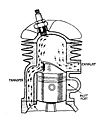Piston facts for kids

A piston is a very important part found in many engines, like those in cars, motorcycles, and even big ships! Think of it like a tight-fitting plug that slides up and down inside a tube called a cylinder. Its main job is to change the space inside the cylinder. It can also push on liquids or gases, or open and close special holes. Sometimes, a rubber seal helps keep oil inside. This seal needs to be changed regularly because it wears out from constant movement.
Contents
How Pistons Create Power
Piston engines turn fuel into movement in two main ways: using a two-stroke cycle or a four-stroke cycle.
Two-Stroke Engines
A single-cylinder two-stroke engine creates power with every turn of its crankshaft. This means it fires more often than a four-stroke engine of the same size. Older two-stroke engines used to create more pollution. However, newer designs, like those with fuel-injection, are much cleaner. Big two-stroke diesel engines, used in ships and trains, have always used fuel injection and produce very little pollution. One of the largest engines in the world, the Wärtsilä-Sulzer RTA96-C, is a two-stroke engine. It's bigger than most two-story houses and has pistons almost 1 metre wide! It's also one of the most efficient engines around.
Four-Stroke Engines
A single-cylinder four-stroke engine creates power only once every two turns of its crankshaft. This means it needs to be larger than a two-stroke engine to make the same amount of power. Four-stroke engines are very common today, especially in cars. Traditionally, two-stroke engines were thought to need more maintenance. Even though simple two-stroke engines have fewer moving parts, they could wear out faster than four-stroke engines. But with modern fuel-injected two-strokes, lubrication and cooling are much better, which helps them last longer.
Steam Engines and Pistons
A steam engine is another type of engine that uses pistons. But unlike car engines, steam engines are external combustion engines. This means the fuel is burned outside the engine to create steam. In most steam engines, the pistons are "double acting." This means steam is sent to both ends of the cylinder, so the piston creates power with every single movement.
Gallery
Other Interesting Engines
- Wankel engine (This is a special type of engine that uses a spinning part instead of a sliding piston!)
Images for kids
-
Pistons inside a petrol engine that has been cut open to show the parts.
-
An internal combustion engine piston, cut open to show the gudgeon pin.
-
A two-stroke deflector piston.
-
An old piston from around 1830 for a beam engine. The seal around the piston is made from wrapped rope.
-
A cast-iron steam engine piston, with a metal ring that is pushed against the cylinder wall by a spring.
See also
 In Spanish: Pistón para niños
In Spanish: Pistón para niños












